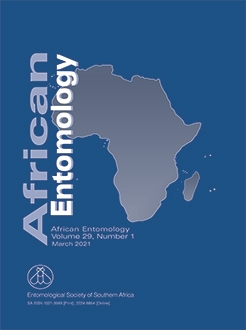Thrips is a harmful cosmopolitan polyphagous pest with marked serious and adverse effects on over 200 host plants, it infests tomatoes, sucking and destroying its seedlings. This study was carried out in a Rogina tomato hybrid field in three governorates, El-Beheira, El-Faiyum and El-Sharqia, in Egypt. In order to evaluate the efficacy of five predatory mites (Mesostigmata: Phytoseiidae) namely; Typhlodrompis swirskii, Phytoseiulus persimilis, Neoseiulus cucumeris, Typhlodromus nigavi and Neoseiulus californicus as well as the recommended combination (abamectin + Egyxide oil) as standard insecticide (1 ml + 2.5 ml/l) separately or combined with each other against Thrips tabaci nymphs and adults. The current study indicated that the single treatment with T. swirskii and N. cucumeris as well as the recommended combination (abamectin + Egyxide oil) were the most efficient as a bioagent control against T. tabaci in tomato plants in all three governorates, followed by T. nigavi, whereas P. persimilis and N. californicus has no role as a biocontrol agent for T. tabaci in single treatment compared with control. Moreover, alternately using predatory T. swirskii in combination with other predators (N. cucumeris, T. nigavi and N. californicus) showed significant reductions (95.8–99.95 %) in T. tabaci populations without any incompatibility or competition between each other compared with control in all three governorates (LSD: 3.46, indicated that there is no significant difference between treatments in all governorates). In general, the reduction effect of all treatments in El-Faiyum was decreased more than the other two governorates. This study demonstrated that T. tabaci in tomato can be reduced by using T. swirskii and N. cucumeris singly or alternately mixing with other predators mentioned above. In the light of these results, the T. swirskii and N. cucumeris singly or alternately should be considered when deciding on the timing of abamectin applications within IPM strategies.
How to translate text using browser tools
23 March 2021
Predacious Effect of Some Predatory Mites on Thrips tabaci Lindeman (Thysanoptera: Thripidae) Infesting Rogina Tomato Hybrid
A.A. Shehawy,
A.M.H. Maklad,
G.H. Ismail,
El-S.M.A. Elsaiedy
ACCESS THE FULL ARTICLE
It is not available for individual sale.
This article is only available to subscribers.
It is not available for individual sale.
It is not available for individual sale.

African Entomology
Vol. 29 • No. 1
March 2021
Vol. 29 • No. 1
March 2021
abamectin
field study
Neoseiulus cucumeris
reduction
Typhlodrompis swirskii





